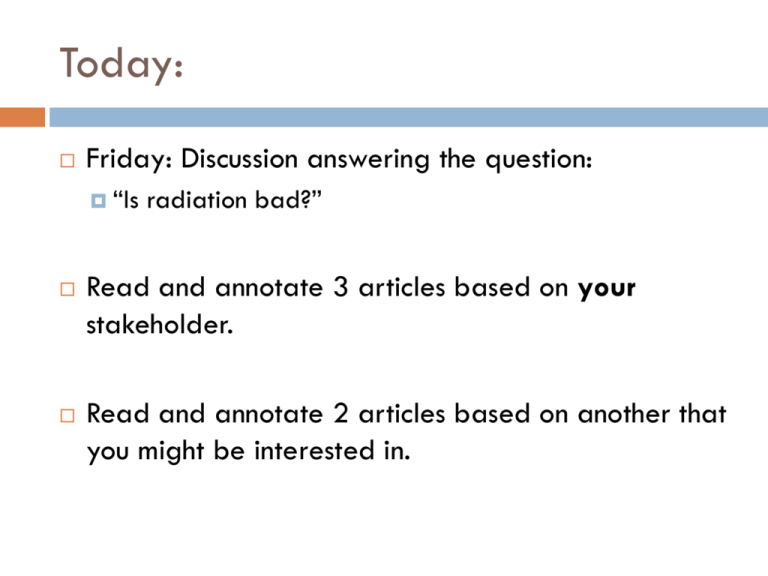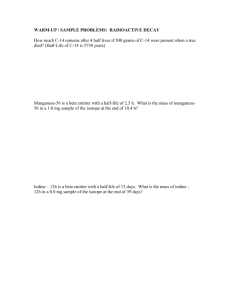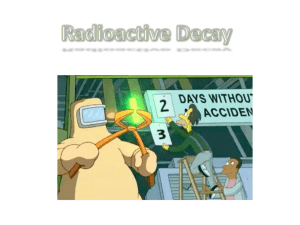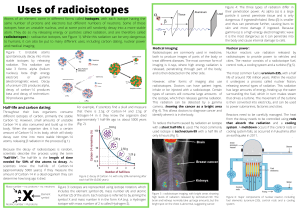Protons, Neutrons and Molar Mass
advertisement

Today: Friday: Discussion answering the question: “Is radiation bad?” Read and annotate 3 articles based on your stakeholder. Read and annotate 2 articles based on another that you might be interested in. Stakeholders Strawberry farmer who irradiates crops Physician who treats radiation poisoning Flight attendant Dental patient getting x-ray Granite quarry worker Soldier on a nuclear submarine Concerned granite countertop owner Concerned consumer of bananas, carrots, lima beans, and brazil nuts Colorado resident concerned about altitude Airline passenger Wyoming resident concerned about Radon X-ray technician Hiroshima survivor Concerned dental patient Cancer patient about to undergo radiation therapy Environmentalist who wants more nuclear power plants Astronaut Fukushima nuclear power plant employee Questions to answer? What source of radiation are you being exposed to? What type of radiation are you being exposed to/emitting? How dangerous is the extra radiation to you? How much radiation are you getting? How much would hurt you? How much are other people getting at the same time or because of you? What kind of decisions should you be making when regarding radiation? Other talking points? Safety precautions? Discussion Prep List of Talking Points from a given perspective (maybe you’re a farmer who irradiates crops) 2 sources at least: can use EPA website from Radiation in Our Lives Worksheet One source should be to learn more about your particular perspective (ex: what is crop irradiation? How does it affect people? What are controversies surrounding it?) Will also have Radiation in Our Lives WS with you Print that out today, ALONG with your work cited and information bullets for you tomorrow. Class Discussion Please have out: Rubric Webquest Article notes Line up at the back of the classroom. Discussion Follow-Up – 10 min-ish (Get out Loose Paper…under doc cam if you need it) On a loose piece of paper, write a minimum of one paragraph reflecting on what you’ve learned through the process. Make it more interesting than: “I learned that radiation is bad.” I want to know what new nuanced understandings about this major issue you will take into the world with you. You may include information you learned earlier or through the process of this research. In summary, what has the process of doing this research and having this discussion taught you? Should be on ~p.98 When finished: Take some time to organize your science journal. Tape all assignments in, make sure that each assignment is on the correct page and update your T.O.C. at the front. Parent Decay Daughter Formation Curve 120 % of Isotope 100 80 And so on… Total Start # of 21Half-Lives Half-Life 25 50Atoms parents; 100 parents; 50daughters daughters 075 remains same 60 40 Average Mm Remaining Average Daughter 20 0 0 1 2 3 4 5 6 7 # Half-lives 8 9 10 11 12 Mm Decay Curve 120 Started with 100 Mm % Remaining 100 50 Mm after 1 Half-life ½ of original 80 60 Can Change # Half-Lives to actual time for each isotope 25 Mm after 2 Half-life ½ of the half 40 And So On… 20 0 0 CarbonUranium-235 14 1 2 3 4 5 6 7 # Half-Lives 8 9 10 11 12 Radiometric Dating Every radioactive isotope has a unique half-life If you know the original amount of an isotope in a sample, and the rate of decay (half-life), it is possible to determine the age of that sample. For C-14 dating, the object must have carbon in it. Object must have died recently enough to still have carbon-14 in it (fossil fuels are too old…they don’t have carbon-14) While plant/animal is alive, has same C-14 concentration as atmosphere (because it is breathing). When it decays, doesn’t replenish C-14 supply, so as C-14 decays, it is possible to date age since death. For U-238 dating, The object must have uranium in it… you get the idea Practice If a sample contains an isotope with a half-life of 20,000 years, how old would the sample be if: Hint: ½ the original isotope remain? Always start by 20,000 years figuring out how many half-lives there were. 1/8 the original isotope remain? 60,000 years What percent of the sample would be left if the sample was 40,000 years old? 25% (or ¼) Radioactive dating game Linked to my web page, or go to: https://phet.colorado.edu/en/simulation/radioactive- dating-game





